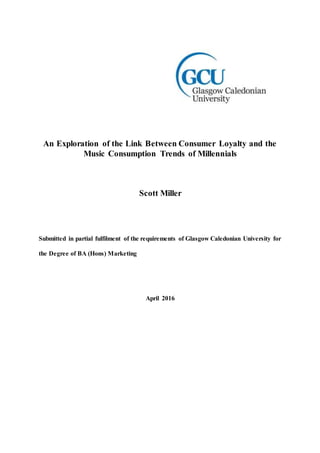This document summarizes a research paper exploring the link between consumer loyalty and music consumption trends of millennials. It provides background on the history of music consumption and how technology has influenced it. The literature review covers topics like the choice between physical and digital music, the impact of artists/bands and social media on consumption, and defining consumer loyalty and trust. The methodology section outlines the mixed quantitative and qualitative research design used, including questionnaires and focus groups with 100+ millennials. Key findings indicate that millennials perceive trust as important when choosing how to consume music and show interest in various platforms.








































































![73
Siwek, S.E. (2007). The True Cost of Sound Recording Piracy to the U.S. Economy.
Available: http://www.ipi.org/ipi_issues/detail/the-true-cost-of-sound-recording-piracy-to-
the-us-economy.
Teddlie, C. and Tashakkori, A. (2011). Mixed Methods Research: Contemporary Issues in an
Emerging Field. The Sage Handbook of Qualitative Research. 1 (3), p285-300.
Thomas, D.R. (2006). A General Inductive Approach for Analysing Qualitative Evaluation
Data. American Journal of Evaluation, Vol. 27, No. 2, p237-246.
Thompson, D. (2015). The Death of Music Sales. Available:
http://www.theatlantic.com/business/archive/2015/01/buying-music-is-so-over/384790/.
Tschmuck, P. (2010). The Recession in the Music Industry - A Cause Analysis. Available:
https://musicbusinessresearch.wordpress.com/2010/03/29/the-recession-in-the-music-
industry-a-cause-analysis/.
Twenge, J.M. (2010), “A review of the empirical evidence on generational differences in
work attitudes”, Journal of Business and Psychology, Vol. 25 No. 2, pp. 201‐210.
UK Essays. November 2013. Explanation of the Concept of Research Onion Psychology
Essay. [online]. Available from: https://www.ukessays.com/essays/psychology/explanation-
of-the-concept-of-research-onion-psychology-essay.php?cref=1.
Wallop, H. (2014). Gen Z, Gen Y, baby boomers - a guide to generations. Available:
http://www.telegraph.co.uk/news/features/11002767/Gen-Z-Gen-Y-baby-boomers-a-guide-
to-the-generations.html.
Walsh, G., Mitchell, V.-W., Frenzel, T. and Wiedmann, K.-P. (2003), “Internet-induced
changes in consumer music procurement behaviour: A German perspective”, Marketing
Intelligence & Planning, Vol. 21 No. 5, pp. 305-317.
Wang, C.-C., Chen, C.-T., Yang, S.-C. and Farn, C.-K. (2009), “Pirate or buy? The
moderating effect of idolatry”, Journal of Business Ethics, Vol. 90 No. 1, pp. 81-93.](https://image.slidesharecdn.com/dd464425-ab6a-409c-a3bd-f0d91738e791-170116032737/85/Dissertation-73-320.jpg)











































